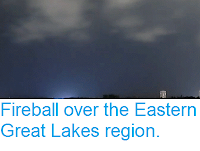Witnesses have reported seeing a bright fireball meteor over much of the Khakassia and Krasnoyarsk republics in southern Siberia at about 6.50 pm local time on Tuesday 6 December 2016. The meteor is reported to habe flaired brightly, but with a 'cold light, like a fluorescent lamp', for three to four seconds, and that about 30 secondes after that a lound bang was heard. Natan Eysmont of the Russian Space Research Institute has suggested that this could have been caused by a small stoney asteroid 10-15 m in diameter.
The 6 December 2016 Siberian fireball meteor as seen from Sayanogorsk in Khakassia. RT.
A fireball
is defined
as a meteor
(shooting star) brighter than the
planet Venus. These are typically caused by pieces of rock burning up in
the atmosphere, but can be the result of man-made space-junk burning up
on re-entry. Objects of this size probably enter the Earth's atmosphere several times
a year, though unless they do so over populated areas they are unlikely
to be noticed. It is possible that this object will have produced meteorites that reached
the surface (an object visible in the sky is a meteor, a rock that falls
from the sky and can be physically held and examined is a meteorite) aound the Babik Valley area, accoriding to local authorities.
See also...
Follow Sciency Thoughts on Facebook.







